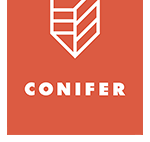
Bringing Audiences to Life Through a Mixed-Method Segmentation Cycle

In a perfect world, brands would have unlimited resources including the time and money to design for and market to the whole population of potential buyers. With their own set of unlimited resources, ethnographers would set up camp in consumers’ homes for weeks at a time, collecting data on the minutiae of domestic life to create the richest data set. Unfortunately (or perhaps, fortunately), resources are not unlimited. Market Segmentation is often the best research answer to carving up the population into more manageable pieces in order to simplify the world of a company's audience. However, quantitative-only market segmentation often falls short of the hopes and dreams of teams when it comes to acting on the insights: oversimplification without accounting for the missing human elements.
At Conifer, we prioritize using a Mixed-Method Segmentation to provide a rich, full perspective to bring audiences to life. A Mixed-Methods approach leverages the power of statistics to break up the universe into manageable chunks of quantitatively defined, significant groups, followed immediately by a deep Qualitative exploration of the highest value and priority segments. Quantitative research helps us focus and know where to dig, and qualitative research uncovers the needs and opportunities for the business to innovate, act and serve.
Designing and balancing these mixed methods is both an art and a science: and it’s important to get them right.
Why We Segment and How it Helps Businesses
Jenny, 35, mother of four, and part-time yoga instructor, buys from Amazon. So does her neighbor, Jonathan, 67, a retired veteran, and grandfather to two kids under 10. Across the country, Sunil, 26, a graduate student and second-generation American, has received three Amazon deliveries this week already and is waiting on a fourth. They all ordered an air fryer last month. In the last 12 months, they’ve all bought a pair of Nike running shoes, shopped at Walmart, and used Facebook Marketplace to search for garage sales in their area.

|

|
 |
At first glance, these buyers seem to have very little in common. If we were to segment them based on, say life stage or lifestyle, each one would fall in a different segment: a young Mom juggling her part-time job and family, a retired grandfather enjoying lots of free time, and a bicultural Gen Z studying hard towards his degree. We would also very likely have them in at least two different segments had we only considered other surface criteria such as their gender, ethnic background, income bracket, or voting habits. But their buying behavior tells us they DO indeed have quite in common: they are all likely driven by convenience, possibly an active and healthy lifestyle, and budget-conscious choices. If we were the manufacturer of a value air fryer that mainly sells through e-commerce, Jenny, Jonathan, and Sunil would all be our bullseye target.
That is exactly what a good segmentation study aims to do: create unique groups that are differentiated from one another in clear, meaningful, identifiable ways. Inside those groups, members should be as alike in their wants, needs, and behaviors as possible. Contrast Jenny, Jonathan, and Sunil with another set of consumers who want convenience, but do not care much about health or budget. Maybe, they only eat take-out or microwaveable dinners. Now consider another set of consumers who, unlike the previous two, take pride in cooking everything from scratch and enjoy preparing elaborate meals using traditional methods only. They may actually enjoy the act of chopping, dicing, searing, stirring, and braising. Clearly, neither of these two latter groups would be ideal targets for our air fryer brand.
So, we did our segmentation study and identified Jenny, Jonathan, Sunil as our targets. Now, what do we do? Do we market the same to each of them? Does an air fryer ad that appeals to Jonathan have equal appeal to Sunil and Jenny? Can we even reach them through the same channels? This is where our “profiling” variables come into play. We may find out Jenny, like most of her “mom friends,” is most reactive to television advertising during the daytime as well as Instagram. Sunil, like most of his peers, prefers streaming services over television and uses TikTok the most. Jonathan might be a whole other kettle of fish, spending most of his social media time on Facebook like many in his retired circle.
On another level, segmentation assists product teams in prioritizing innovation, filling gaps in the market, and ensuring the right kinds of products are being developed. Although each of our consumers bought an air fryer last month, and convenience was a motivating factor for all of them, Sunil’s motivations for buying include the fact that he’s a useless cook but struggles with eating out due to budget constraints. Further, since he primarily eats by himself, he only wants a small air fryer that will not take up too much space in his tiny apartment. Jonathan is a great cook but wants something that’s easier to clean and uses less oil (he’s worried about his cholesterol). He mostly cooks for himself and his wife, so like Sunil, he prefers a smaller model, but perhaps one with more options to indulge his love of variety. Jenny, on the other hand, wants her roasted vegetables in half the time. However, she has five other mouths to feed, so she wants the biggest model that she can afford. Make cooking easier, cleaner, faster, and healthier. And make it fit my household, my living space, and my budget. This is the kind of information product teams crave.
In short, across all levels of business, segmentation is the key to growth. Without it, the whole game is a shot in the dark.
Types of Segments and the Segmentation Process
Market segmentation helps researchers and marketers aggregate buyers into groups with some common characteristics that are meaningful for their business with the premise that those common characteristics, whatever they may be, will make them more likely to think, act and respond in similar ways. There are a variety of ways to segment prospective buyers, including demographic, geographic, behavioral, and psychographic segmentation. An apparel company may choose to target a certain age cohort and gear its product line, positioning, and advertising toward that demographic only. A national restaurant chain may customize its menu based on the unique flavor and dietary preferences of its patrons by region. An insurance company may execute very different messaging for their lapsed, new, and repeat customers. A hotel chain may decide to prioritize business travelers and focus all new products and services on their unique needs only.
Another type of segmentation that is very powerful, but in our opinion under-utilized, is needs-based segmentation which divides consumers into groups based on their needs and wants, or benefits they are seeking when they make a purchase. The premise of needs-based segmentation is that people with the same needs will gravitate toward the same products regardless of their demographic, geographic, behavioral, or psychographic differences. When they are at the point of purchase, how they prioritize their needs will determine which product benefits and attributes they prioritize and ultimately which product they choose. Need-based segmentation is especially powerful for identifying white spaces in any category. It is not uncommon to find a significant cluster of consumers who prioritize a certain set of needs and yet no existing product in the market fulfills those needs.
Each research team has its own approach to segmentation. A robust segmentation process usually has three phases:

Phase 1 - Discovery: Using qualitative research to discover who our audience is, what their needs are, and attitudes they hold, their values, and buying behaviors.

Phase 2 – Segmentation: Here we get down to the numbers. How do we group people based on what we now know about them, how many groups, what are the sizes of those groups, and who should we focus on? There is no one right answer and we often evaluate multiple alternatives until we identify the one solution that is most meaningful, practical, and actionable.

Phase 3 – Validation & Activation: The final link in the cycle, this is when we bring our segments to life with another round of focused qualitative research: who are they, what do they do, how do they live, what do they need, want and value? What most matters to them?
The segmentation process, although statistical at its core, has an art and experience component too. Drilling down on the population to form segments helps narrow down and laser-focus marketing initiatives. But a one-size-fits-all approach (marketing Nike running shoes to those under 35 with a high disposable income, because they’re our biggest buyer group) misses the nuances that contribute to real growth and innovation. A surface-level segmentation may tell us where the most dollars lie, or where the most loyal customers are, but it doesn’t reveal hidden areas for growth. It fails to inform on a gap in the market just waiting to be tapped.
A common thing we see is when clients have been working with or have inherited legacy segments based on psychographics or demographics alone that often perpetuate assumptions and oversimplify key groups. With a more robust segmentation process, we often find that the core needs of a user may be much more diverse and complex.
Here at Conifer, we use a variety of methodologies in our analytics to reveal deeper insights for segmentation. From k-means clustering to Latent Class Analysis (LCA) using MaxDiff scaling, we combine cutting-edge analytics to create more relevant, meaningful segmentation for businesses.
Using tech devices as an example, even within the most ‘tech savvy’ segment, there may be a vast divergence in needs and how users engage with products. A professional photographer and an engineer may be equally tech-savvy but require very different experiences. If this group is a strategic target, finding the sub-segments within them may be critical to both product marketing and development teams. Some may prioritize speed, capacity, cross-device compatibility, or key features that support their personal hobbies or workflows. Analytics like k-means, MaxDiff, and Latent Class Analysis allows us to decipher critical differences in needs within the target group to market to their specific needs and uncover gaps in the market where needs aren’t yet being sufficiently met.
Qualitative v Quantitative Research Methods and Why We Use a Mixed-Method Approach to Bring Audiences to Life
The battle of quant vs qual is an epic and ongoing one. Executives making big business decisions love hard facts. Quantitative numbers are an excellent tool for creating a sexy presentation full of graphs and graphics. They’re persuasive. Qualitative data, however, fills in the ‘why’ to quantitative’s what, how, where, and when. The argument around qualitative vs quantitative research misses a crucial point: both are always better.
“Traditional methods, such as surveys and questionnaires, have value in providing quick snapshots but are subject to significant biases. Algorithm-based big data are great at seeing what choices are made but lack the underlying understanding of why decisions were made.
More than ever, marketers must break through this rational layer to understand the emotional context: what is the reasoning behind these stated and actual choices? What was someone feeling at every moment along the path toward a decision – and what were the true influencers of those decisions.” – Peter Hartzbech, The GreenBook GRIT Report, 2022
Choosing a mixed-method research approach combines the best of qualitative and quantitative research. Each method requires a different skill set and mindset, which is why you need a team with expertise and experience in both methodologies. The “Goldilocks point” at which qual and quant meet to deliver the most meaningful and impactful segmentation is where the art factor (read: born of experience and expertise) comes into play.
How Segmentation Refresh Keeps Audiences Alive and Kicking Buying
Many businesses segment in their startup years, only to never refresh those segments again. Some may consider refreshing when they launch a new product category. Others (hint: the most successful ones) know that a mixed-method segmentation cycle should be a priority at least every 5 years, if not sooner when other forces are at work. Brands should be asking themselves: How have recent events such as the pandemic affected our buyers? Is record inflation changing buyer behavior in my segments? Are technologies and products developing so quickly that our segments are less relevant now than they were when created? Have marketing channels advanced, and which is more effective now for different buyers?
Back to data storage again. Just a couple of years ago, data storage was a domain inhabited solely by the most tech-savvy of consumers, those with large quantities of data to store, and the latest gadgets. A niche market. One that most of the population was unsure about. Certainly not something you’d advertise on prime-time television inside reruns of Everybody Loves Raymond. Nowadays, segments in the data storage space look very different. Jonathan is an iPhone user and he’s got his own Apple iCloud storage plan. So do Jenny and Sunil. The WFH phenomenon has created a whole new (and substantial) segment of consumers. The pandemic, a temporary shift, has created long-term priorities such as convenience shopping that impact all kinds of markets. For the data storage industry, which moves at lightning speed, segment refresh is non-negotiable. For other industries, recent events have shaken up the market in unprecedented ways. But segmenting is not only essential but also more complicated than ever.

As Nurca Yener-Bozkurt, Senior Quant Manager at Conifer Research, puts it, “Segmentation is about building a story, and that story needs to make sense. Humans have hidden motivations, reasons, and stories. Our job is to uncover those. A mixed-method segmentation cycle reveals new or altered segments in time to act.”
Whether there’s a global crisis like the pandemic happening or not, brands should consider a re-evaluation of their market segmentation every few years. We suggest not only a re-think around segmentation, but a full and ongoing qualitative and quantitative segmentation cycle, to discover new patterns, segment the market, and delve more deeply into these segments to create comprehensive personas. (Qual, quant, and then qual again.) The most successful businesses are those that stay up to date on their segmentation, get ahead of trends, and focus their energies on the right areas for growth.
